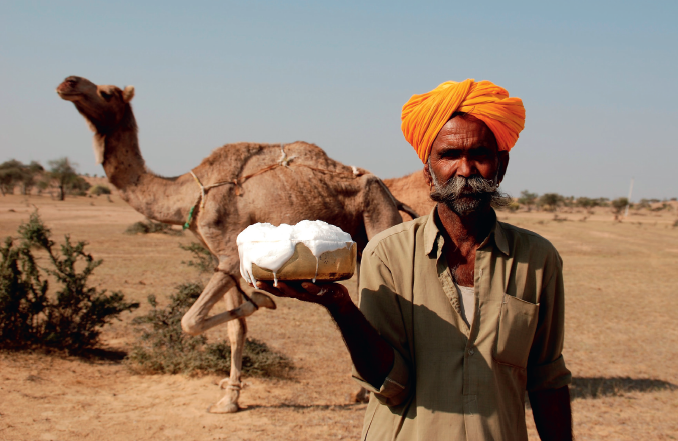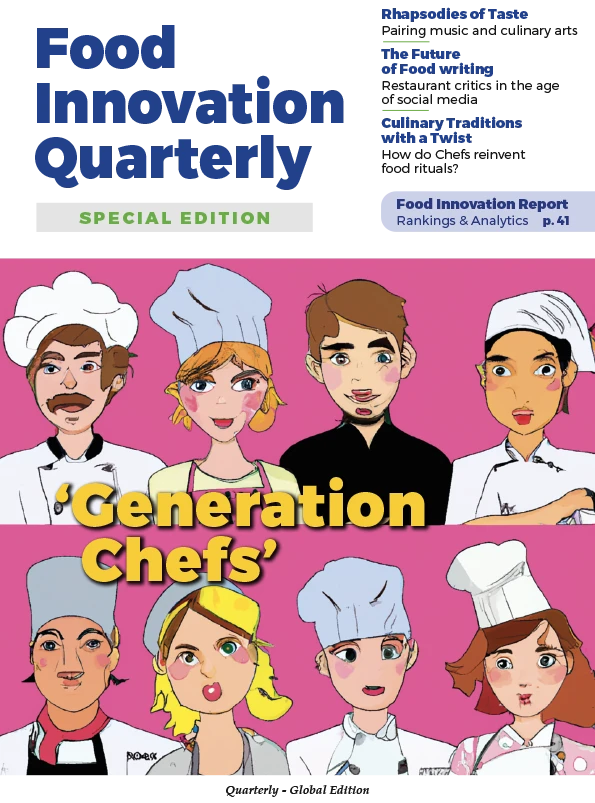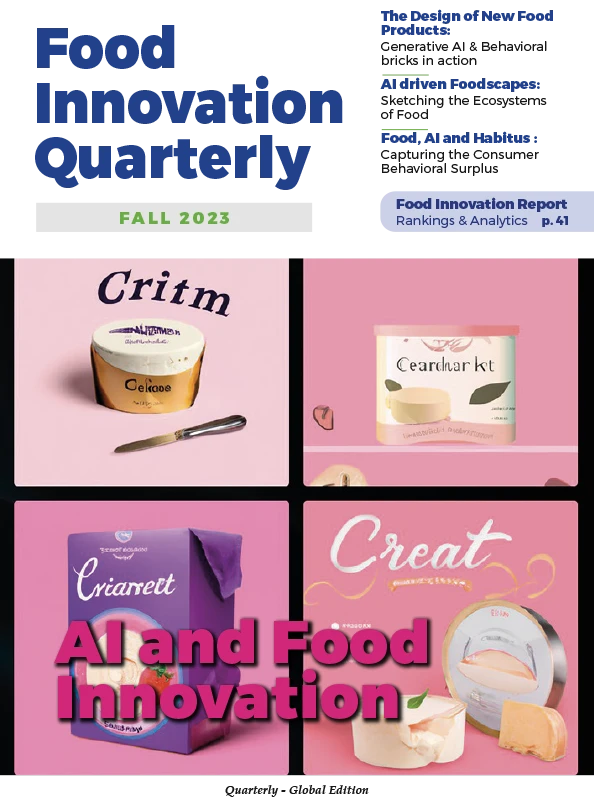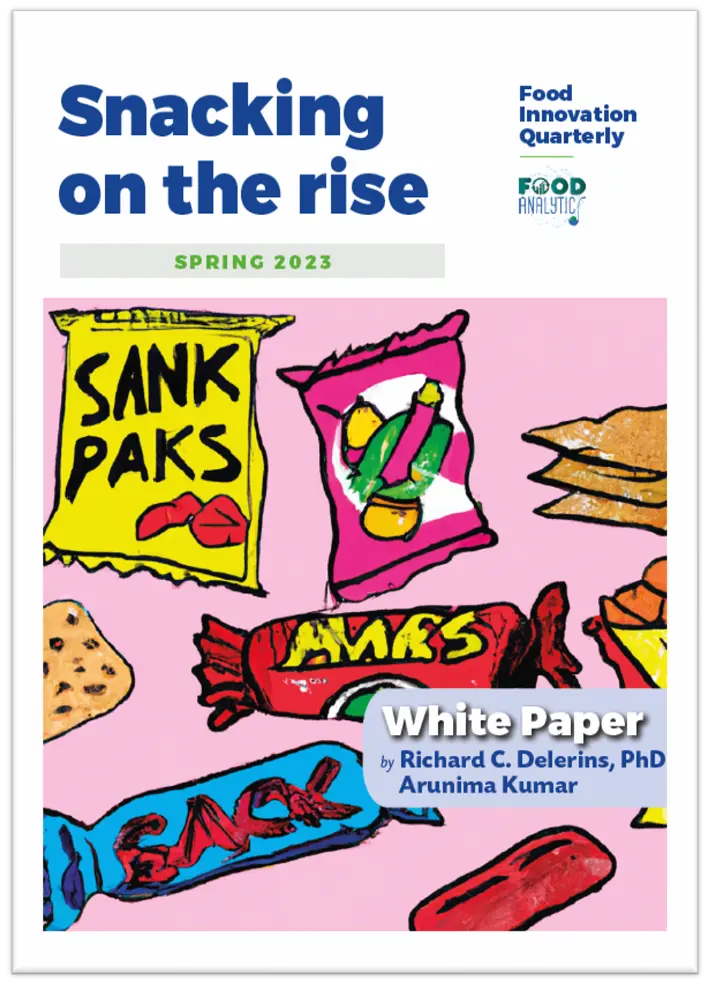As I pack dried brewer’s spent grain for an unexpected customer, I realize how innovation in cheese making can stem from the most unlikely sources. My small business in Bangalore, India, revolves around repurposing the by-product of the city’s booming microbrewery scene, which boasts around 60 establishments. Brewers’ spent grain, rich in protein and fiber, carries remnants of its original malty flavor, and it’s about to play a role in an exciting cheese-making experiment.
My unexpected customer, Namrata Sundaresan, is a cheese maker and educator who runs an award-winning cheese brand called Käse Cheese, based out of Chennai. Inspired by a traditional Italian cheese, Vacchino, she plans to age her cheese using spent grain instead of hay, and I can’t wait to see the results of this experiment!
Once a traditional craft limited to pastoral and dairy-centric communities, cheesemaking in India has transcended its origins to capture global interest. The evolution of cheese in India mirrors a shift from mass-produced, shelf-stable varieties to artisanal, European-inspired creations. Today, Indian cheese reflects a fascinating fusion of culinary traditions, blending local flavors with international influences.
History of Cheese & India
India’s rich dairy heritage has deeply influenced its cheese-making opportunities, with the availability of milk playing a pivotal role in fostering innovative models to support livelihoods and sustain biodiversity. While paneer is a familiar cheese in India, there’s a wide array of traditional Indian cheeses that reflect unique regional influences. Doodh Roti/ Kalari, is made from raw cow, buffalo, or goat’s milk by Gujjar shepherds in the mountains of Jammu and Kashmir. The milk is gently heated while stirring vigorously, coagulated with «matthar» (sour whey), shaped into rounds, and then sun-dried. Chhurpi is a cheese made from the milk produced by chauri – a cross between a male yak and a female cow. Best known for being hard as a rock, Chhurpi stems from the Eastern Himalayan region, from Ilam in Nepal, Tibet, Bhutan, Sikkim, and also Darjeeling and Kalimpong.
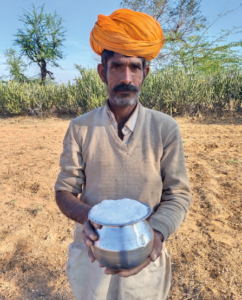
Chhena or Chhana and Bandel are both acid-set cheese. Chhena is mostly used to make sweets while Bandel, a 16th century Portuguese influenced cheese named after the city it comes from in Bengal, is kneaded, salted and smoked.
Topli or Surti Paneer is a rennet curdled cheese originating from Surat, Gujarat, traditionally made by the Parsi community. Traditionally curdled with animal rennet like dried chicken gizzard linings the cheese is then placed in Toplis’ or Tokris – wicker baskets – where the cheese is shaped and rested and then stored in its own whey.
Dairy has been an integral part of India’s culinary and agricultural history since ancient times. The Indus Valley Civilization, one of the world’s earliest urban cultures, was known to produce dairy and dairy products. This historical connection has definitely influenced contemporary cheese-making endeavors.
The significance of dairy in India’s socioeconomic landscape became more pronounced during the White Revolution, spearheaded by Dr. Verghese Kurien in the 1970s. Aiming to modernize India’s dairy industry and boost milk production through cooperative dairy societies, Dr. Kurien’s efforts led to the establishment of the National Dairy Development Board (NDDB) and the creation of innovative dairy products like Toned Milk, adjusting milk’s fat content to meet consumer preferences.
The introduction of technologies for milk powder production and distribution further revolutionized India’s dairy sector, expanding its reach, availability, and diversification. Additionally, the surplus milk generated by the White Revolution prompted the development of value-added dairy products like paneer, set curd, ice cream, and ghee.
Despite these developments, cheese as such remained relatively unexplored until recent years. Traditional Indian cuisine predominantly features dairy products like ghee, yogurt, and paneer, while aged cheeses have been less common. However, the emergence of artisanal cheese makers has sparked a new wave of Indian cheese, with a focus on quality, innovation, and sustainability.
The milk
Cheese making in India has become a platform for creativity and entrepreneurship, particularly in rural communities. Mansi Jasani, a cheesemonger, super juror at the World Cheese Awards and founder of The Cheese Collective, emphasizes the importance of using high-quality raw milk to produce artisanal cheeses that reflect the unique terroir of India’s diverse regions. By harnessing the rich biodiversity and cultural heritage of India, cheese makers are able to create distinctive cheeses that cater to local tastes while also attracting international attention.
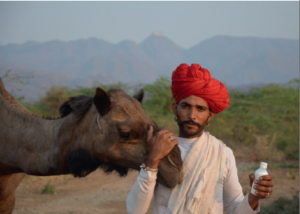
Pastoral communities play a crucial role in India’s dairy sector, with their traditional knowledge contributing to sustainable farming practices. These communities have a deep understanding of their local ecosystems and livestock, allowing them to adapt to changing environmental conditions. However, pastoralists often face challenges such as land encroachment, limited access to education, and loss of traditional grazing lands, which threaten their way of life.
Organizations like the Centre for Pastoralism are working to address these challenges by supporting pastoralists and raising awareness about their contributions to the economy. By undertaking research, developing collaborative programs, and advocating for policy reforms, these organizations seek to enhance the livelihood security of pastoral communities and promote the sustainable management of natural resources.
Established in 2007, Himalayan Cheese is best known for its Kalari, a traditional Indian cheese similar to mozzarella, crafted by the Gujjar Shepherds of Pahalgam and other regions of Jammu and Kashmir. Chris Zandee, the founder of Himalayan Cheese, explains, «We began with Western cheese, knowing that our valley has a rich cheese and dairy heritage, but we wanted to focus more on incorporating local cheese. This made our cheese-making establishment more locally owned and less of a Western venture. »
«We didn’t start out looking for cheese or local cheese. Our goal was to establish a venture that would work alongside farmers, empower them, and contribute to their development, » says Zandee. «Milk came, and with it, cheese. We realized that we could make a daily impact on farmers by converting milk into cheese. Kalari cheese, I believe, is the best expression of our intentions and efforts for the local farmers here. »
Asma Sayed, the co-founder of Bombay Fromagerie, started her recent career in cheese not from a love for cheese perspective, but by studying social entrepreneurship models that could empower communities using cheesemaking. She worked with Access Livelihoods (ALC), a social enterprise that incubates and supports businesses established by marginalized communities. ALC provides training and mentorship to young entrepreneurs, empowering them to develop dairy-based enterprises.
Panchal Dairy is one such enterprise, founded by members of the local Rabari community. By producing goat and sheep milk cheeses and collaborating with organizations like Sahjeevan and the Centre for Pastoralism, Panchal Dairy aims to support pastoralists while fostering cheese making that can become a traditional practice and cheeses to become indigenous to the area.
Käse Cheese, a Chennai-based company, partnered with local entrepreneurs like Panchal Dairy and provided technical expertise, helping to develop a wide range of high-quality cheeses, including cow, buffalo, and goat milk varieties. Through their platform Namrata Sundaresan, co-founder of Käse Cheese, emphasizes the importance of preserving India’s cheese-making traditions while embracing innovation.
Camel Charisma, founded in 2010 by Hanwant Singh Rathore and Dr. Ilse Kohler-Rollefson, exemplifies a social enterprise that utilizes cheese making to support pastoral communities. Working closely with the Raika community in Rajasthan, it is dedicated to promoting camel husbandry and creating sustainable livelihood opportunities. Through the development of innovative camel milk products like cream cheese and feta, it empowers pastoralists while also conserving indigenous camel breeds.
Dr. Rollefson explains, «The taste of camel milk, which is very similar to cow milk, changes depending on the diet of the camels. Some trees and herbs, such as bordi (Zizyphus nummularia) and the Indian Globe Thistle (Echinops echinatus), sweeten the milk, while others, like neem, may give it a bitter tinge or a salty hint. »
According to Raika traditional knowledge, camels feed on up to 36 different Ayurvedic plants, affecting not only the taste of their milk but also enhancing its medicinal properties, making it beneficial for individuals with diabetes, liver problems, asthma, and other illnesses.
At the same time, through the preservation of traditional pastoral practices, Camel Charisma contributes to the biodiversity of the region.
The culture
« How do we eat this? » Namrata recalls being one of the first questions she was asked at a cheese tasting almost a decade ago. With traditional cheeses like paneer or kalari being cooked, or newer cheeses like mozzarella being seen used on a pizza or melted in a sandwich, the culture of cheese consumption is relatively new in India; an exciting challenge for cheese makers like Namrata.
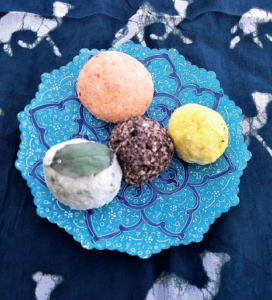
Namrata’s Milagai Podi Cheddar at Käse, also known as an Ode to Chennai, is crusted with a house blend of Milagai Podi just before it’s packed, a dry spice powder condiment that can be eaten with anything, from hot rice and ghee to dosas.
But it’s not just familiar ingredients that make this approach innovative. Namrata’s instructions on how best to enjoy eating the cheese are to grate it onto a dosa! A cheese + podi dosa is an existing familiar indulgence and the most enjoyable and relatable snack. This offers customers a new approach to experiencing, understanding, and learning about cheddar.
With consumer tastes and trust evolving, cheese mongers like Mansi have witnessed the industry grow over the last decade, and actively encourage people to try newer cheeses. «There’s definitely more awareness, I see people who have worked or studied abroad and crave artisanal cheese. More access to information, through the internet, blogs, and Instagram, leads to different ways to eat and make cheese. »
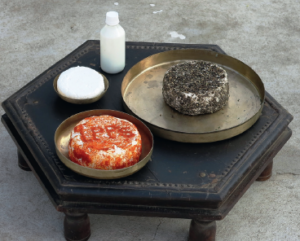
There’s been a lot of focus on local flavors and spices incorporated in the process of making cheese, such as coconut oil or local spices. But many cheese makers are looking to their lands, local ingredients, and cultures to build their own hyperlocal flavors and cheeses. Darima Farms in Northern India was established in 2017, in a remote village in the Himalayas, at an altitude of 7,000 feet, surrounded by thick oak and rhododendron forests.
Their Zarai is named after a local Uttarakhandi spice mix which features fenugreek, mustard, cumin, chili, pepper, and rock salt. These spices are mixed into the cow milk, for a subtle flavor in the aged cheese.
Chefs and restaurants play a significant role in creating new avenues and opportunities for Indian cheese, partnering with local providers. Opedro’s Portuguese Green Pea Rice for instance is made by cooking rice and green pea tendrils in an ambrosial stock that is finished with a fresh herb vinaigrette and a creamy burrata on top, sourced from Eleftheria Cheese. Similarly, Geist Brewing Co. in Bangalore has a Burrata Butter Chicken on their menu that uses Burrata instead of cream, introducing customers to a new cheese.
The terroir
Venturing beyond mere ingredients and flavors, let’s zoom out and explore the innovative strides in education, design communication, and the culture surrounding cheese in India.
In recent years, Indian cheese has made its mark on the global stage. Consider Super Juror Mansi Jasani, who has represented India at the World Cheese Awards, serving as the sole Indian representative on the judging panel. In the past three years alone, three Indian cheeses have claimed prestigious awards.
Currently, the fourth-best cheese in the world hails from Mumbai, courtesy of Eleftheria, a Mumbai-based artisanal micro-creamery founded by Mausam Jotwani Narang. Notably, it’s the first brown cheese in India, modeled after the traditional Norwegian whey cheese. Crafted with whey (a by-product of cheesemaking), milk, and cream, it boasts a rich taste akin to salted caramel milk fudge. In 2021, it earned a silver medal, a first for an Indian cheese.
In 2022, Eleftheria clinched gold for their Moony, a cloth-bound cheddar. Additionally, Käse Cheese secured a bronze title for their lavender-infused cheddar.
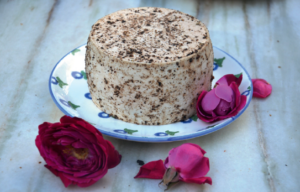
Artisanal cheese making in India obviously follows various styles adopted from western cheese making but Mansi calls for cheese makers to start also creating unique identities for their cheese.
“While they might be making the recipe or style of a western cheese, Indian cheese makers are still using Indian milk, and making it in India. As much Indian as a cheese can be. I would encourage them to find a unique name and identity for it. Marketing does of course play a role because consumers know only those 8-10 varieties of cheese, but as the market, community and awareness grows, there will be a shift in the identity of Indian cheese.”
Like the earlier mentioned Zarai, she recalls another cheese that through its name has a bold identity: the Tomme de Semmancheri from The Farm. Located in the small hamlet of Semmancheri in Chennai, The Farm is one of the few farmsteads, artisanal cheese makers in the country who raise their bovines on the farm.
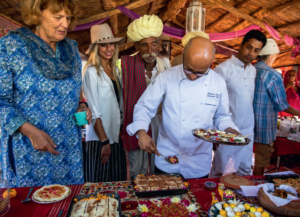
Cheese mongers like Mansi have seen the way the industry has evolved and grown over the last decade, as people developed trust. She deems it important to make people try newer cheese and for instance looks at local festivals and holidays as ways to get cheese out to people, such as Diwali, for new and novel gifting concepts through cheese.
Namrata, on the other hand, explores pairing cheeses with familiar commodities and flavors like coffee or chocolate, to enhance understanding of cheese flavor profiles and consumption experiences and education. She also runs a level one course at the Academy of Cheese. And while the course does advertise knowing your “Le Gruyère from your Gorgonzola”, the program is built around understanding the Indian supply chain and current ecosystem as a core part of the cheese learning process.
The recent formation of the Desi Dairy Dialogue community, spearheaded by Namrata, Mansi, and others, underscores the need for cheese makers to understand natural cheese-making practices and foster collaboration. The inaugural community meet-up at The Farm in Chennai brought together cheese makers, pastoral dairies, cheese mongers, and fermentation specialists, celebrating craftsmanship and collectively elevating the taste and appreciation of artisanal cheese across India.
It’s been two months since my initial conversation with Namrata, and I find myself eagerly tasting her new cheeses, a tomme and a goat’s cheese aged with brewers’ spent grain: they are delicious.
The nascent space of cheese in the Indian food landscape presents opportunities not to be bound by tradition but rather inspired by historical food culture, flavors, and ingredients. It’s about adapting to modern changing landscapes. Most importantly, it’s about leveraging cheese-making to build innovative models, uplift livelihoods, and sustain biodiversity, as exemplified by the pastoral communities.
With each bite of cheese, the journey of innovation in Indian cheese-making unfolds, promising a future brimming with creativity, flavor, and cultural celebration.


